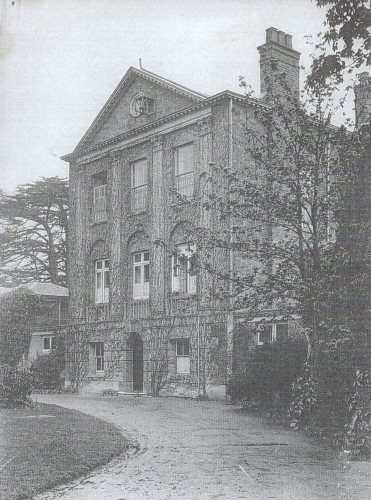We are very pleased to share the second in a series of posts by Manchester historian, Andrew Simpson. Here he is going back to his roots and looking at Well Hall House in Eltham, where Edith Nesbit the well-known and much-loved children’s writer lived.
Recreating the lost Well Hall House with Edith Nesbit
Well Hall House has passed out of living memory. It was built in 1733, was home to some Eltham notables and was demolished in 1930. It stood between Well Hall Road and the moat and replaced the Tudor manor house which Sir Gregory Page knocked down to build his fine 18th century house.
But a building which dominated Well Hall, and was known by many seems to have left little trace. There are a few photographs a handful of maps and the land records of the tithe schedule. Together these show a tall building which ran to three floors, had a wing on each side and was set in an estate of about 33 acres including a front garden, a walled garden to the south, the moat , three ponds, a stream and much meadow and pasture land along with the farm buildings which included the present Tudor Barn.

A little to the north were Well Hall Cottages which in the 1840’s had been a complex of six properties but by 1911 seem to have become a farmhouse and one cottage. But Well Hall House was sufficiently enclosed that I doubt the cottages proved much of an intrusion, and so within its grounds the occupants of the big house got on with their favoured lives wandering the fourteen rooms and looking out east across the fields and west across their gardens.

Judging by the photographs I am not sure it was a place that would have caught my fancy. It was tall and the design fitted that classical style of balance so that what you saw on one side was replicated on the other.
All of which is not much for a house which stood for just under two hundred years, but as these things work there is one other source of information, and that comes from Edith Nesbit, the novelist who lived in the house from the late 19th century into the twentieth. Contained in some of her books are references to Eltham, Well Hall and the house itself. And of these it is The Red House written in 1902 which provides some wonderful insights into the place.

The back of Well Hall House from the Paddock and moat, 1909
The book itself is a light account of the lives of a newly married couple who inherit the Red House and choose to live there. In the course of the year that follows Mrs Nesbit describes in some detail the house, its gardens, the nearby cottages with references to the village the parish church and offers up walk on parts for both Woolwich and Blackheath.
But it is the house which draws you in, with its panelled rooms, great hall, vaulted cellars and kitchen still with the equipment which would have been in use through the 18th and 19th centuries. Added to this there are observations about the rooms which had been much messed about by changing fashion.
Now like all such descriptions I suspect there will be points when the Red House departs from the actuality of the original, but I am confident that there is more that will have been the same than less. This in turn stretched to her descriptions of the gardens, including the walled one, the presence of the railway with its station and embankment and the parish church.
Edith and her husband Hubert had taken on the house and 7 acres of the land. Of course there may be more sources of information sitting in the Greenwich Heritage Centre and in the letters of the people who visited Edith and her husband at Well Hall which included the Webb’s, H.G.Wells and Bernard Shaw but in the meantime the Red House seems to have done the old place proud.
Location; Well Hall, London
Pictures; Well Hall House circa 1909, from The story of Royal Eltham, R.R.C. Gregory, 1909 and published on The Story of Royal Eltham, by Roy Ayers
https://chorltonhistory.blogspot.co.uk/2016/02/recreating-lost-well-hall-house-with.html

2 responses to “Recreating the lost Well Hall House with Edith Nesbit”
A nice bit of research. The house is, by the way, in the Palladian style.
LikeLiked by 1 person
Thank you Martha!
LikeLike